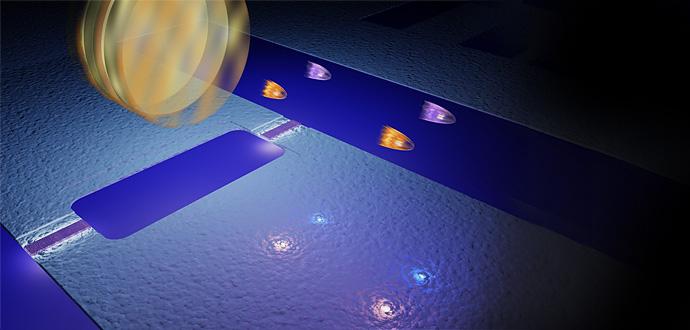Creating photons from a vacuum
November 21, 2011

In the Chalmers scientists’ experiments, virtual photons bounce off a “mirror” that vibrates at a speed that is almost as high as the speed of light. The round mirror in the picture is a symbol, and under that is the quantum electronic component (referred to as a SQUID), which acts as a mirror. This makes real photons appear (in pairs) in vacuum. (credit: Philip Krantz, Chalmers)
Scientists at Chalmers University of Technology in Sweden have succeeded in creating photons from a vacuum.
The experiment is based on one of the most counterintuitive but most important principles in quantum mechanics: that a vacuum is by not empty, but full of “virtual particles” that are continuously fluctuating in and out of existence.
The static Casimir effect, proposed by Dutch physicist Hendrik Casimir in 1948, involves two perfectly reflecting parallel mirrors that, when placed in a vacuum, will be attracted to one another.
Physicist Gerald Moore predicted in 1970 that if a mirror is moved at a significant fraction of the speed of light, the electromagnetic field does not have time to adjust, but instead becomes excited and as a result generates real photons. The phenomenon, known as the dynamical Casimir effect, has now been observed for the first time in an experiment.
“Since it’s not possible to get a mirror to move fast enough, we’ve developed another method for achieving the same effect,” explains Per Delsing, Professor of Experimental Physics at Chalmers. “Instead of varying the physical distance to a mirror, we’ve varied the electrical distance to an electrical short circuit that acts as a mirror for microwaves.”
The “mirror” consists of a quantum electronic component referred to as a SQUID (Superconducting quantum interference device), which is extremely sensitive to magnetic fields. By changing the direction of the magnetic field several billions of times a second, the scientists were able to make the virtual mirror vibrate at a speed of up to 25 percent of the speed of light.
“The result was that photons appeared in pairs from the vacuum, which we were able to measure in the form of microwave radiation,” says Per Delsing. “We were also able to establish that the radiation had precisely the same properties that quantum theory says it should have when photons appear in pairs in this way.”
What happens during the experiment is that the “mirror” transfers some of its kinetic energy to virtual photons, which helps them to materialize. Göran Johansson, Associate Professor of Theoretical Physics, explains that the reason why photons appear in the experiment is that they lack mass.
“Relatively little energy is therefore required in order to excite them out of their virtual state. In principle, one could also create other particles from vacuum, such as electrons or protons, but that would require a lot more energy.”
The finding may be of use in the research field of quantum information, which includes the development of quantum computers.
However, the main value of the experiment is that it increases our understanding of basic physical concepts, such as vacuum fluctuations, the constant appearance and disappearance of virtual particles in vacuum. It is believed that vacuum fluctuations may have a connection with “dark energy,” which drives the accelerated expansion of the universe. The discovery of this acceleration was recognized this year with the award of the Nobel Prize in Physics.
Ref.: C. M. Wilson, G. Johansson, A. Pourkabirian, M. Simoen, J. R. Johansson, T. Duty, F. Nori, P. Delsing. Observation of the dynamical Casimir effect in a superconducting circuit. Nature, 2011; 479 (7373): 376 [DOI:10.1038/nature10561]